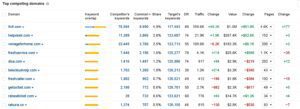This article was originally published in the Elevate Your Marketing newsletter and has been repurposed and republished here with the author’s permission. Here is the link to the original article.
Identifying the right target accounts is one of the most important steps of any account based marketing program. While mature organizations do not struggle with this, early-stage companies often find that to be a difficult task. It’s usually not because they don’t know their target criteria well. Rather, they don’t know all the possible ways in which they can find the right accounts to go after. This article will help them overcome that challenge.
We will be discussing 12 ways to find target accounts for your business – irrespective of the niche you are in. Some of these techniques will also be useful for mature organizations that are looking for newer ways of identifying accounts.
Fuel your account based marketing strategy with 12 ways to find target accounts
1. Your own data
This is the simplest yet the most overlooked of all the methods. If you have been doing business for a while, you are very likely to have a healthy list of accounts lying in your CRM or marketing automation tool.
Many a time, what happens is that these accounts in the company’s own database stay untouched without any remarketing activities. And one of the best ways to build a highly targeted list of accounts is to tap into this internal data.
2. B2B databases
This is probably the most common of all the external sources you would depend on for building a TAL (Target Account List). B2B databases like ZoomInfo and Crunchbase help you create a list of accounts by firmographic (and sometimes technographic) criteria – such as industry, revenue, region, number of employees, etc.
Depending on the database you are using, the search criteria might change. For instance, Demandbase offers technographic data of target accounts using which you can filter accounts based on their tech stack.
3. Your own network
Just like how you would look within (as explained in method #1), you also need to look around. Think about people in your network who could:
- be your potential customers (influencers or decision makers in relevant accounts).
- refer you to relevant people within their organization.
- point you to accounts/people that could be your customers.
4. Visitor tracking tools
Visitor tracking tools are nothing but tools that help you identify the accounts visiting your website. Examples include Factors AI, LeadFeeder, VisitorQueue, and LeadForensics. You can do this even for specific pages of the website. This would enable you to identify intent better. For example, the accounts visiting your product page are more likely to be your potential customers than those visiting the careers page.
5. Intent intelligence tools
This is my favorite, and probably the most expensive among all the methods.
Intent intelligence platforms like Demandbase, Terminus, and 6sense analyze content consumption patterns online to identify accounts that have the highest propensity to buy what you offer.
Pro tip: You can use these tools to identify accounts that are surging for more than one of your offerings to create a universal TAL rather than product or service-specific account lists.
Also read: Navigating the ABM jungle – what is ABM and what is an ABM platform?
6. Industry events and conferences
This method is time-consuming, but worth it – because, unlike the other methods in the list, events offer the ability to interact directly with your potential customers.
Let’s look at the two ways in which you can identify target accounts in events and conferences:
- By identifying potential customers from companies exhibiting or participating in an event (you can collect this data either from the event host’s website or by physically or digitally attending the event.
- By networking at the event (I guess this doesn’t need an explanation).
7. Online events and webinars
Online conferences today offer various avenues to interact with each other like 1 to 1 e-meeting setups and chat rooms. All these are opportunities for you to look for potential buyers.
In addition to these, here are a few more ways in which you can identify prospects during online events and webinars:
- Once you RSVP for an event on LinkedIn, you will be able to see who else is attending the event. You can go check out the companies where these people are working. You might identify some new accounts that were not previously on your radar (this is a time-consuming process. So make sure you have enough people to work on this before initiating this. As you know, focus is key in marketing. Hence, prioritize what’s most important for you always).
- Chats and interactions during events: Some online event platforms allow attendees to leave comments in public. LinkedIn live events are an example of this. Irrespective of the streaming platform you use for it, people attending the event on LinkedIn can use the comment section as a chat window. This is another place where you can identify prospect accounts.
- Purchase the data from the host: Some event hosts sell the data of their attendees to interested parties to generate additional revenue from the event. If that’s an option, go for it. This is one of the easiest but slightly more expensive ways to acquire account data.
Related article: Webinar Marketing – Everything You Need To Know
8. Partners
Partnerships are one of the biggest levers of growth for any B2B business. But most partners wouldn’t be sharing their leads or target account data unless you have a strategic partnership with them.
In the B2B space, businesses have multiple tiers of partnership. Usually, the top-tier partnership involves combined go-to-market activities wherein both partners share campaign and target account data with each other. This is typically possible only when you get into a mature stage of collaboration with high levels of trust – with each partner adding a tremendous amount of value to the other.
Partnerships are also an excellent tool for identifying relevant high-intent accounts. For instance, if your company is into offering Workday implementation and support services, getting a list of accounts using Workday – from the company Workday itself – in your geography of interest is a great way to build a highly targeted account list.
9. Analyst and market research reports
Analyst organizations publish reports annually on leaders in different niches. Gartner’s magic quadrant and Forrester wave are examples of this. Analysts also publish detailed reports mentioning the key players in various domains.
There are also reports published by various market research organizations such as MarketsandMarkets and Research And Markets. You can easily find market research reports in your niche by googling ‘market research reports in {target market name}’.
10. Look alike lists
Look-alike lists broadly refer to lists generated by keeping a base list of accounts as a reference. This is a powerful method to generate a new list of accounts based on the characteristics of an account list you already have.
Here are a few ways in which you can generate look-alike account lists:
- Intent tools like Demandbase come with a feature to generate look-alike lists based on the firmographic characteristics and intent signals shown by a reference list.
- A simple yet effective technique is to take each account in your existing TAL and google ‘{company name} competitors’. Websites like G2, ZoomInfo, Owler, etc., will give you a list of companies in the same space. Here as well, you need to do additional filtering to pick the most relevant accounts for your business.
11. Competing domains
Finding the list of competing domains using a tool like Ahrefs is usually seen as an SEO activity alone. But it’s a super cool way of identifying target accounts.
This is what you need to do for this:
- Take the key accounts in your target account list.
- Plug the domains of these companies’ websites into the competing domains section of any SEO tool (I use Ahrefs for this).
- Select your region/geo of interest.
- From the list of domains you get, filter out blogs and other irrelevant websites.
Now you have a refined list of target accounts that you otherwise might have missed. For example, have a look at the screenshot below to get the list of top 10 competing domains of Freshworks in the US.

12. Accounts interacting with personal posts
This is probably the least used of all the techniques we discussed today.
As you might be knowing, LinkedIn’s post analytics shows you the top accounts that interacted with your content. So, if your employees make it a practice to collate the list of relevant accounts viewing their content whenever they post something related to the business, over time you will have a great list of target accounts that have already seen your content.
This requires an unconventional approach where you need to encourage those who post to collate and share the data with you. To make it easier for them, you can have a person from the marketing team do the consolidation (of data from multiple people) and account qualification. You can also incentivize your employees by offering gifts or conducting contests.
Final words
Identifying target accounts is only one of the first steps in your B2B demand generation and lead generation journey. So, instead of overdoing it or spending too much effort on this, try to move on to the next stages (like campaign planning, content strategy, messaging strategy, etc.) pretty quickly.
Also, please note that the tools I mentioned in this article are just taken as examples. If you plan to consider any of those, please make sure to do a thorough evaluation on your own. You can always reach out to us at info@skalegrow.com in case you need any help.
Skalegrow – account based marketing agency
Skalegrow was founded with the aim of addressing the gap of not having a B2B marketing agency that can deliver results the way clients want. Not that any agency in the world isn’t doing it. It’s more like there aren’t many that are doing a good job at it, especially in account based marketing.
Skalegrow offers account based marketing services in the form of consulting engagements as well as end-to-end implementation – including implementing a tech stack, creating content, running campaigns, and more. Please write to us at info@skalegrow.com for more details on it.
About the author

Naseef KPO is the Founder and CEO of Skalegrow. He comes with rich experience across multiple areas of B2B marketing including content marketing, demand generation, SEO, account-based marketing, marketing analytics, revenue attribution, marketing technology, etc. He writes thought-provoking and relevant articles on The Skalegrow Blog and his weekly LinkedIn newsletter Elevate Your Marketing.
Prior to starting Skalegrow, Naseef led large marketing teams in multi-million dollar B2B organizations where he made significant contributions to the topline growth of the business. He has also appeared on numerous podcasts where he shared his thoughts on trending marketing topics such as the application of AI in marketing, startup marketing, ABM, and B2B content marketing, just to name a few. Being the founder of Skalegrow, he is currently focusing on helping its clients stay ahead of their competition by using innovative yet practical marketing tactics.
You can connect with Naseef KPO on LinkedIn.


